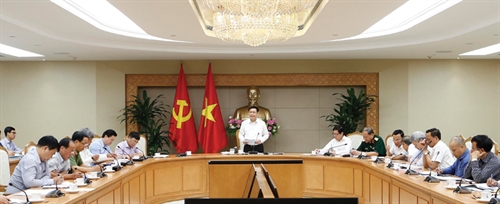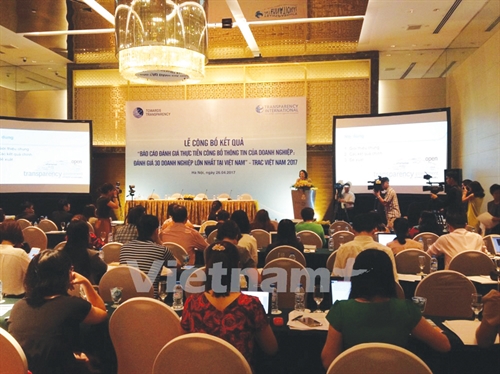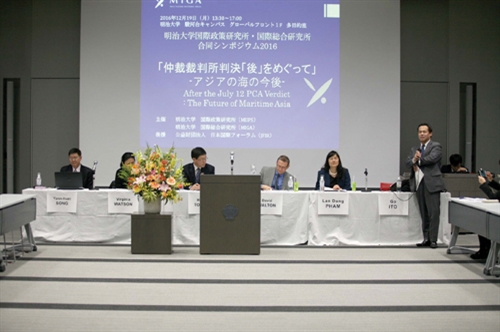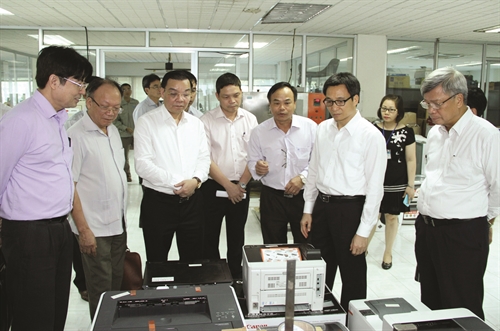By Pham Thanh Trung, Vu Hai Yen, Hoang Thuy Linh[1]
Equitization of state-owned enterprises (SOEs) in Vietnam was piloted in 1990-91 at different speeds in each phase. According to a government report, during 2011-15, 508 SOEs were equitized.[2] The speed of equitizing big SOEs has been recognized to increase significantly over the past five years. As of October 2016, there remained 718 companies in which the State held 100% of charter capital.[3] For the period from 2016 to 2020, the Government has identified enterprises where the State holds 100% of capital and dominant shares, including those operating in key industries, important geographical areas, and security and defense fields, applying high technologies, requiring large-scale investment and creating socio-economic impetus that lack investment from other sources.[4]
Experiences have shown that during the initial period of equitization, lack of transparency and undervaluation of assets created opportunities for certain groups of interest to grab state assets through the seemingly strict regulations.[5]
The current legal framework on information disclosure and transparency in the equitization of SOEs, including regulations of the Law on Anti-Corruption and various decrees on equitization, is not sufficient and detailed, so the implementation in practice has not been satisfactory.
In order to have a smooth and effective process of equitization, the State must ensure the entire process is transparent as much as possible, so that state assets (more concisely, assets of the people) will be converted at fair market prices and the people may know about it. Also, a monitoring mechanism must be in place to prevent underhand agreement or compromise between parties involved in this process.
General regulations
Apart from financial statements and audit statements which all SOEs must disclose periodically as stipulated in Decree 81/2015/ND-CP on information disclosure of SOEs,[6] SOEs conducting equitization must disclose equitization plans, their value and adjustment of their value.
Regarding equitization plans
The Law on Anti-Corruption only contains one general provision listing the liability of SOEs to disclose their equitization plans.
In conformity with the Law on Anti-Corruption, Decree 59/2011/ND-CP on conversion of enterprises with 100% state capital into joint stock companies (Decree 59) also requires SOEs to disclose their equitization plans.[7] Such equitization plan must contain the following basic contents: actual situation of the enterprise at the time of valuation, valuation results and issues that need further processing, form of equitization, charter capital structure, reserve price and method of issuing shares, labor restructuring plan, production and business plan for the next 3-5 years, and land use plan approved by competent authorities.[8] As per Decree 59, the Steering Committee for Enterprise Equitization will direct the supporting team to work with the enterprise and coordinate with the consultancy organization (if any) to disclose the equitization plan and send it to every unit in the enterprise for study before organizing an extraordinary staff meeting.[9]
The above publicized equitization plan is not a final one as the enterprise must organize a staff meeting after which the equitization plan will be finalized and submitted to a competent authority for consideration. Then, the Steering Committee for Enterprise Equitization will appraise the plan and report it to a competent authority for approval.[10]
Regarding value of an equitized enterprise and adjustment of this value
Decree 59 stipulates that disclosure of enterprise value is the responsibility of the authorities competent to decide on the enterprise value (maybe the Prime Minister, ministers of line ministries or chairpersons of provincial-level People’s Committees), but the Law on Anti-Corruption also puts such responsibility on representatives of the state owner in enterprises.[11] Disclosure of the value of an equitized enterprise is necessary to provide investors with information needed for their decision making. Also, the enterprise’s officials and employees can appeal to competent state authorities if they find such value is unreasonable and inappropriate with the real value of the enterprise. For instance, Cho Lon Investment and Import-Export Company Ltd. (Cholimex) was valued at VND 620 billion, but its staff and other stakeholders disagreed with this valuation. This was reported to the Corporate Finance Department and Inspectorate of Ho Chi Minh City. In the end, a loss of nearly VND 250 billion was detected.[12]
According to Decree 59, an equitized enterprise can adjust its announced value in two cases: (i) there are objective reasons which affect the value of the enterprise’s assets; and (ii) no shares have been sold 12 months after the time of valuation, except special cases as decided by the Prime Minister. Adjustment of the enterprise value will affect the decision of investors and thus any adjustment must be publicly disclosed.[13]
 |
| Deputy Prime Minister Vuong Dinh Hue addresses a meeting of the Steering Committee for Enterprise Renewal and Development on restructuring of state enterprises in the first half of 2017__Photo: Doan Tan/VNA |
Regulations on information disclosure and transparency in the equitization process
Disclosure during the process of financial settlement and enterprise valuation
Equitization of SOEs can be understood as a way that the state assets are gradually transferred to the private sector at an appropriate price.[14] Therefore, valuation of enterprises is a very important stage in the whole equitization process. Losses mainly occur in this stage and one of the main reasons is that assets are undervalued compared to the market price.
Concerning this issue, the Ministry of Finance issued Circular 127/2014/TT-BTC guiding the financial settlement and enterprise valuation when converting wholly state-owned enterprises into join stock companies (Circular 127). One of the principles of equitization is that the process of financial settlement and valuation of enterprise must be overt and transparent and does not cause any losses of state capital and assets.[15]
Regarding financial settlement, Circular 127 provides for carrying out financial settlement when an enterprise is valuated and at the time the equitized enterprise is officially converted into a joint stock company. The financial settlement includes several items such as disposal of assets, handling of receivable debts, payable liabilities, contingencies, profit or loss, reward fund, and welfare fund, of which disclosure is requested at certain stages such as: (i) for the disposal of assets which are no longer needed and accrued assets waiting for liquidation, the liquidation or sale of these assets must be done by means of public auction; (ii) enterprises must disclose the incomplete check of tax finalization when disclosing information for selling shares to investors; and (iii) the distribution of the welfare fund, reward fund and the list of employees enjoying such distribution must be disclosed to the employees.[16]
Valuation of enterprises, one of the most important and time-consuming tasks, can be seen causing much loss during the equitization. The consultant will select the method of valuation. Once it is done, the consultant together with the enterprise will prepare a dossier of enterprise valuation.[17] This process requires direction and strict supervision, otherwise, the collusion between enterprises and valuation consultants can easily take place, causing loss to enterprises but bringing benefits to some groups. The question is how to determine the true value of the enterprise in order to avoid loss of state capital and be acceptable to shareholders.
At present, regulations on valuation of enterprises still contain many shortcomings and inadequacies, especially in the valuation of the land of which the real value is not yet recognized. For instance, according to the regulations, for the land leased with annual payment of land rental, such land rental will not be included in the value of the enterprise.[18] This means that although how costly the actual value of the land is, that value will not be included in the valuation of the enterprise to serve the equitization. This makes the value of the enterprise much lower than its market price, thus creating benefits to some individuals/private firms,[19] and causing huge losses during the valuation process.
Recently, the Vietnam Feature Film studio has been acquired by a waterway transport business and this raised the question whether the new owner of the equitized enterprise is interested in its business or in the land under the management and use of such enterprise?[20] The enterprise is valuated for sale without including the area of land leased with annual payment of rental, so if comparing the value of shares sold with the area of leased land used by this equitized enterprise, the new owner has bought the land at a very good price.
Another example is the above-mentioned case of Cholimex. This company has an industrial zone project which had been completed for more than 90 percent and was for lease already. However, at the time of equitization, Cholimex did not account for such lease and its profits. Later, the Inspectorate discovered a loss of nearly VND 250 billion.[21] Or a state-owned company in Tan Binh district, Ho Chi Minh City, did not complete the financial finalization for its finished project, thus complaints were brought to competent agencies. After finalizing the project, the value of the enterprise increased by more than VND 100 billion and an additional tax of VND 20 billion was paid to the state budget.[22] Therefore, it is suggested that in order to avoid losses of state assets, during the valuation of enterprises, each phase of the project must be completely finalized.[23]
Beside these general regulations, Circular 127 does not have specific regulations on how to practice disclosure during the enterprise valuation. According to experts, the lack of disclosure and transparency of information as required by international practices not only raises doubts about group interests but also limits the participation of investors in the Vietnamese market due to their scrupulosity.[24]
Disclosure and transparency in selling shares
After the equitization plan is approved, the initial public offering will be carried out with the following methods: public auction, direct negotiation and underwriting.
When organizing an auction irrespective of institutional investors, individual investors, domestic investors and foreign investors, a public auction will be used. At least 20 working days before holding the auction, the Steering Committee for Enterprise Equitization must coordinate with the stock exchange or an intermediary financial institution to disclose the information at the enterprise, at the auction place and in the mass media.[25]
The information to be disclosed is specified in Annex 2 to Circular 196/2011/TT-BTC. In addition to basic information about the enterprise itself, other important information is also subject to disclosure for investors to make decision, such as: corporate value, business situation and production and business results in three consecutive years preceding the equitization, mode of sale and payment for the shares, plan to use the proceeds from equitization, and anticipated risks. The reserve price of shares being sold at auction is also announced along with information about the enterprise.[26] Selling shares through public auction can ensure the disclosure and transparency and create opportunities for all interested parties to buy shares if the bid is good. Investors intending to buy large numbers of stocks can also buy them fairly through the auction. Public auction can be viewed as the best way to valuate an enterprise since investors will pay for the shares at the value of the enterprise’s assets. Also, the public auction will help avoid negative incidents such as group interests.[27]
In case the auction fails, the unsold shares will be publicly offered for sale through direct negotiation. Then, the Steering Committee for Enterprise Equitization will decide on the announcement of such sales (including information on the equitized enterprise as described above) at least five working days before the date when investors subscribe to the shares.[28]
Direct negotiation may also be applied when selling shares to strategic investors. The selection of strategic investors has become a “hot” issue as most entities having large areas of land in Hanoi and Ho Chi Minh City selected their strategic investors being business groups having huge capital and operating in the real estate or financial sector which are not related to the core business of the equitized entities.[29] Whereas, according to Decree 59, strategic investors are the ones with financial capacity who provide a written undertaking from an authorized person that their long-term interests are closely connected with the enterprise and support the enterprise after equitization in transfer of new technology; training of human resources; enhancement of financial capacity and corporate governance; supply of raw materials; and expansion of the outlet market.
The selection of strategic investors has a very important meaning, in many cases, it will decide the future of the enterprise after equitization. However, under the current law, the criteria for selection of strategic investors should be submitted or reported to the competent authority only,[30] thus not ensuring disclosure and transparency.
Selling shares to strategic investors can also be carried out in the form of an agreement prior to the auction to the general public[31], therefore, the underhand arrangement, acquisition or purchase of shares for other purposes can still take place, causing loss of state capital.[32] There have been some cases where enterprises had only one strategic investor subscribing to shares and they carried out the sales through direct negotiation. Such process does not ensure the principle of disclosure, transparency and market principles during the equitization.[33]
Regulations on forms of disclosure
Current regulations on disclosure of information on equitization are not sufficient. Only provisions on disclosure of equitization plans are mentioned in Decree 59 as “disclose the equitization plan and send it to every unit of the company for study before organizing a staff meeting”; however, this disclosure seems to serve internal meetings of the enterprise only. Besides, it is not clear in which form the enterprise will disclose information and to what target groups. Is it an internal disclosure or public disclosure? For other information to be disclosed, Decree 59 and Circular 127 have not provided in detail.
Implementation of regulations on information disclosure
As analyzed above, Decree 59 does not require the disclosure of the final equitization plan, however, in practice, through searching the internet, one can easily find decisions approving equitization plans on the websites of the enterprises, Government portal or other web pages.[34]
Not much information can be found on the disclosure by enterprises of information about the process of financial settlement and valuation of enterprises. It seems that this disclosure requirement has been only on paper and not yet been implemented in practice. Perhaps, it is due to the lack of provisions detailing the implementation of such requirement. No requirements on disclosure of detailed information during the process of valuation may lead to overconfidence and discretion of the valuation organization. According to the Government Inspectorate, when valuating assets in kind, some valuation consultants do not comply with the principle of “market value”, fail to fully carry out the process of valuation, and use old-fashioned and obsolete accounting data as a basis for valuation and therefore enterprises’ assets are often under-valuated.[35] Such issues have been recognized by management authorities, thus, the Prime Minister has assigned the State Audit Office of Vietnam to continue reviewing and re-auditing in order to clearly determine the value of enterprises and to assess the quality of consultancy firms for ensuring the correctness, adequacy and accuracy of this activity.[36]
Regarding the sale of shares to strategic investors, although current regulations show that the criteria for selection of strategic investors are not required to be disclosed to the general public, from the portals/web pages, one can easily find invitations to strategic investors for buying shares for the equitization, in which general and specific criteria for selection of strategic investors have been stated.[37] In addition, some line ministries have publicized decisions approving criteria and the process for selection of strategic investors when conducting equitization of subordinate companies.
Recommendations
As analyzed above, the legal requirements on information disclosure in the equitization of SOEs still contain some shortcomings. The Ministry of Finance is currently drafting a new decree on equitization of SOEs. Appropriate amendments should be made in this new decree to further strengthen the disclosure and transparency in equitization for the wider public knowledge.
Despite the fact that the final decisions approving equitization plans can be found on various webpages and/or websites, it is still needed to have a clear provision in legal documents to affirm and bind the responsibilities of relevant stakeholders. This provision must also aim at disclosing to the general public instead of reporting to competent authorities only.
In many cases, equitized enterprises have been under-valuated. Then, if the enterprise selects strategic investors and uses the method of direct negotiation rather than selling shares at public auction, the investor will be able to purchase shares at an “incredulous” price, bringing them huge benefits. Therefore, some information relating to the valuation process like the method of valuation used by the consultants, how to valuate the equitized enterprise, etc., must be publicly disclosed so that the staff or other stakeholders are well informed. This helps them monitor the valuation process in order to avoid improper valuation which may cause loss of money and property of the State.
Lack of transparency in the sale of shares may lead to collusion between the parties for sharing the benefits. In fact, recently, there have been some cases where invitations to strategic investors were abused to settle the benefits of interest groups during the process of equitization. The regulations on selling shares to strategic investors need to ensure comprehensive disclosure. Therefore, the sale of shares to any strategic investors should only be done after conducting a sale at a public auction (the sale prior to public auction is not applicable). Selling shares to strategic investors must also be conducted via public auction among strategic investors. Even in cases where there is only one strategic investor subscribing to shares, sale through direct negotiation as prescribed by the current regulations should not be allowed, rather, sale should be done at public auction with the participation of other ordinary investors.-
https://baochinhphu.vn/Thi-truong/TOAN-CANH-Hoi-nghi-toan-quoc-sap-xep-doi-moi-DNNN/293430.vgp [accessed on 23/12/2016].
(https://baochinhphu.vn/Thi-truong/TOAN-CANH-Hoi-nghi-toan-quoc-sap-xep-doi-moi-DNNN/293430.vgp) [accessed on 23/12/2016].









